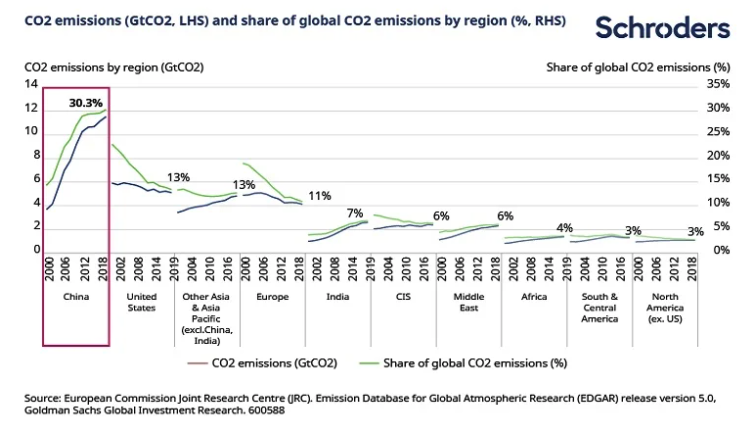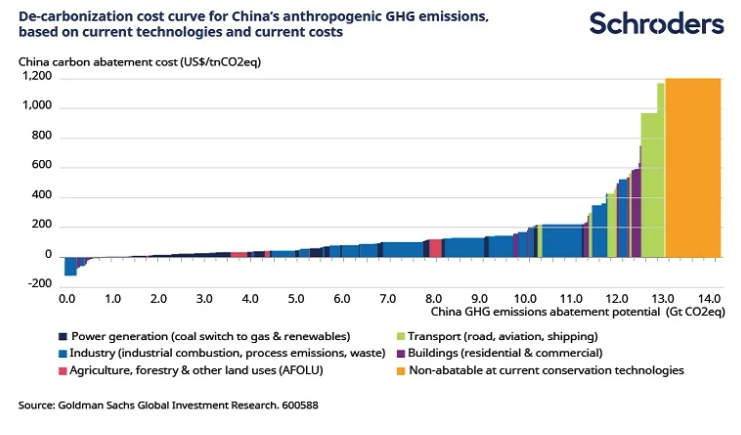
Can China really become carbon net zero by 2060?

At the UN General Assembly in September 2020 China’s President Xi Jinping pledged that the country would become net zero by 2060. This was a surprise move that has been hailed as a significant step forward in the global effort to address the Climate Crisis, given that China is responsible for around 30% of global emissions. He also pledged that China’s emissions would peak before 2030, having previously committed to peak emissions “around” 2030.
However, this announcement came in the same year that China approved plans to build new coal plants at the fastest rate since 2015, proposing to add an additional 40 gigawatts (GW). For context, the total UK electricity generation capacity from all sources is 107GW. So, is China serious about decarbonising? And how does a country that consumes more coal that the rest of the world combined get to carbon neutrality?
Discover more from Schroders:
– Learn: What are the three ‘P’s of sustainable investing?
– Listen: Why the 21st century belongs to Asia
– Learn: FOMO market is over – what next?

How will China get to net zero carbon emissions?
Energy: Decarbonising the energy mix is the simplest piece of the puzzle, but still represents a dramatic transformation and a phenomenal task. In 2019, coal accounted for around 65% of China’s electricity generation. To achieve net zero by 2060 implies that power from non-fossil fuels will likely have to top 85% by 2060. This shift will have to occur in the context of an expected tripling of total electricity demand (according to 2021 estimates by Goldman Sachs).
The levelised cost of electricity (the average cost of electricity produced by a generating plant over its lifetime) from wind and solar is already lower than new coal plants and will soon become cheaper than running existing plants. The technological solution is commercial without subsidies. Deployment needs to accelerate, and we are seeing concrete near-term targets to support this: under the 14th Five Year Plan (covering 2021-2025) China is aiming for 500GW of new wind and solar combined and for non-fossil fuels to make up 20% of primary energy use by 2025.
Mobility: China already has the largest electric vehicle market in the world, driven by various ‘carrot and stick’ policies to promote new energy vehicles (NEVs) over internal combustion engine (ICE) vehicles. As the NEV industry continues to expand, cost parity with ICE vehicles is expected to be reached over the next 2-3 years and subsidies will fall away.
By 2025, NEVs are expected to account for 20% of new car sales, from 5% in 2019 (according to research by Goldman Sachs). On that assumption, NEVs would still account for fewer than 10% of the total passenger vehicle fleet in 2025, a number that needs to reach around 100% by 2060 if the net zero target is to be met.
Industry: Industry accounts for more than a quarter of China’s emissions. It will likely be the most challenging sector to decarbonise, but there are some tentative signs that President Xi’s announcement is catalysing action. For example, in January, China’s largest steelmaker committed to become net zero by 2050 in the first such announcement by a major Chinese steel company. Baowu Steel is responsible for 5% of global production and has pledged to reach peak emissions in 2023 and reduce carbon emissions by 30% by 2025.
With Chinese companies making up six of the top 10 global steel producers, and steel production accounting for 15% of the country’s CO2 emissions, we would expect others to follow suit to fall in line with the government pledge. While the exact pathway to decarbonisation still needs to be spelled out, not least because the average age of China’s steel plant fleet is only 10-15 years, this is a hugely important commitment.
Carbon pricing: Various regional pilot carbon trading schemes have been in place since 2014, and in February 2021 new measures for a national carbon trading scheme were announced. Proper carbon pricing is a critical tool for any net zero effort, but this scheme is unlikely to have a significant impact in the short term.
In the first phase it only covers power generation, the carbon price is low (around $6/tonne vs more than $35/tonne in the EU), and it remains to be seen how tightly compliance will be enforced. As China’s abatement cost curve (an estimate of the cost of reducing emissions in a given year) demonstrates, meaningful progress will only be made with materially higher carbon prices and with a broader scope of emissions covered.

How will it impact investors?
Whilst a lot of work remains to be done, the commitment to net zero further strengthens the secular growth story for the tools of decarbonisation such as renewables, electric vehicles, green hydrogen, energy storage and carbon capture and storage. According to one estimate, the clean tech investment opportunity could be as high as $16 trillion (2021 estimates by Goldman Sachs).
China has a history of using industrial policy to forge leadership positions in key technologies and so it seems likely that the key beneficiaries will be the domestic companies. One thing is clear: climate change investors cannot afford to ignore the Chinese market.
Topics:
– For more visit Schroders insights and follow Schroders on twitter.
Important Information: This communication is marketing material. The views and opinions contained herein are those of the author(s) on this page, and may not necessarily represent views expressed or reflected in other Schroders communications, strategies or funds. This material is intended to be for information purposes only and is not intended as promotional material in any respect. The material is not intended as an offer or solicitation for the purchase or sale of any financial instrument. It is not intended to provide and should not be relied on for accounting, legal or tax advice, or investment recommendations. Reliance should not be placed on the views and information in this document when taking individual investment and/or strategic decisions. Past performance is not a reliable indicator of future results. The value of an investment can go down as well as up and is not guaranteed. All investments involve risks including the risk of possible loss of principal. Information herein is believed to be reliable but Schroders does not warrant its completeness or accuracy. Some information quoted was obtained from external sources we consider to be reliable. No responsibility can be accepted for errors of fact obtained from third parties, and this data may change with market conditions. This does not exclude any duty or liability that Schroders has to its customers under any regulatory system. Regions/ sectors shown for illustrative purposes only and should not be viewed as a recommendation to buy/sell. The opinions in this material include some forecasted views. We believe we are basing our expectations and beliefs on reasonable assumptions within the bounds of what we currently know. However, there is no guarantee than any forecasts or opinions will be realised. These views and opinions may change. To the extent that you are in North America, this content is issued by Schroder Investment Management North America Inc., an indirect wholly owned subsidiary of Schroders plc and SEC registered adviser providing asset management products and services to clients in the US and Canada. For all other users, this content is issued by Schroder Investment Management Limited, 1 London Wall Place, London EC2Y 5AU. Registered No. 1893220 England. Authorised and regulated by the Financial Conduct Authority.